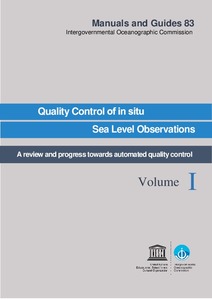| dc.contributor.editor | Pérez Gomez, Begoña | |
| dc.contributor.editor | Aarup, Thorkild | |
| dc.contributor.editor | Bradshaw, Elizabeth | |
| dc.contributor.editor | Illigner, Julia | |
| dc.contributor.editor | Matthews, Andrew | |
| dc.contributor.editor | Mitchell, Bill | |
| dc.contributor.editor | Rickards, Lesley | |
| dc.contributor.editor | Stone, Peter | |
| dc.contributor.editor | Widlansky, Matthew | |
| dc.date.accessioned | 2020-06-02T16:14:03Z | |
| dc.date.available | 2020-06-02T16:14:03Z | |
| dc.date.issued | 2020 | |
| dc.identifier.citation | UNESCO/IOC (2020) Quality Control of in situ Sea Level Observations: A Review and Progress towards Automated Quality Control, Vol. 1. (eds. Pérez Gómez, B., et al). Paris, France, UNESCO, 70pp. ( IOC Manuals and Guides No.83, Vol. 1). (IOC/2020/MG/83Vol.1). DOI: http://dx.doi.org/10.25607/OBP-854 | en_US |
| dc.identifier.uri | http://hdl.handle.net/11329/1348 | |
| dc.identifier.uri | http://dx.doi.org/10.25607/OBP-854 | |
| dc.description.abstract | The Global Sea-Level Observing System (GLOSS, https://www.gloss-sealevel.org/) is an international programme conducted under the auspices of the Intergovernmental Oceanographic Commission (IOC) of UNESCO. GLOSS aims at the establishment of high quality global and regional sea level networks for application to climate, oceanographic and coastal sea level research. The programme became known as GLOSS as it provides data for deriving the 'Global Level of the Sea Surface'. A major component of GLOSS is the 'Global Core Network' (GCN) of approximately 300 sea level stations around the world for long-term climate change and oceanographic sea level monitoring (Figure 1). The Core Network is designed to provide an approximately evenly-distributed sampling of global coastal sea level variations. GLOSS can be considered a component of IOC's Global Ocean Observing System (GOOS), and particularly as a major contributor to its Climate and Coastal Modules. In appreciation of the multiple uses of tide gauges, GLOSS has also sought to provide sea level data that meets the standards and requirements for tsunami warning and storm surge monitoring. Numerous GLOSS GCN stations have for many years contributed to the Pacific Tsunami Warning and Mitigation System (PTWS) and, following the 2004 Sumatra Earthquake, the IOC in consultation with GLOSS, has taken an active role in coordinating and implementing the sea level networks for the Indian Ocean Tsunami Warning and Mitigation System (IOTWMS), the Tsunami and other Coastal Hazards Warning System for the Caribbean and Adjacent Regions (CARIBE-EWS), and the Tsunami Early Warning and Mitigation System in the North-Eastern Atlantic, the Mediterranean and Connected Seas (NEAMTWS) (http://www.ioc-tsunami.org/).
Data from more than 70 countries are contributed to GLOSS, and in particular to the GLOSS Data Centres including the Permanent Service for Mean Sea-Level (PSMSL). However, quality control, although defined originally within the GLOSS programme, is accomplished at different levels and by different institutions and programmes at this moment. In addition, many sea level stations are not committed to GLOSS and the number of organizations dealing with tide gauge data (originators, facilitators and users) has increased. Thus, it is necessary to bring up to date the current good practice and distribute the information widely as a means of realizing a more standardized approach to quality control. Application of standardized sea level quality control, and agreed filtering techniques, will ensure that tide gauge data supplied to sea level data banks are consistent, and of a known accuracy. This will allow future researchers to better define confidence limits when applying these data.
The objective of this manual is to compile and update the standards and best practices on quality control of tide gauge data. Although related information has been included in the IOC Manuals on Sea Level Measurement and Interpretation (Volumes I (1985), II (1994), III (2002), IV (2006) and V (2016)), this is the first time that detailed information on these quality control procedures has been assembled into one document, addressing new issues like automation, for management of hundreds of long time series, or near-real time quality control procedures, for operational applications. | en_US |
| dc.language.iso | en | en_US |
| dc.publisher | UNESCO | en_US |
| dc.relation.ispartofseries | IOC Manuals and Guides; 83, Vol. 1 | |
| dc.subject.other | Tide gauge data | en_US |
| dc.subject.other | GLOSS Data Centres | en_US |
| dc.subject.other | Quality control | en_US |
| dc.subject.other | Global Sea-Level Observing System (GLOSS) | en_US |
| dc.subject.other | Sea level data | en_US |
| dc.title | Quality Control of in situ Sea Level Observations: a Review and Progress towards Automated Quality Control, Vol. 1. | en_US |
| dc.type | Report | en_US |
| dc.description.status | Published | en_US |
| dc.format.pages | 70pp. | en_US |
| dc.description.notes | Contributors and providers of other information:
Ruth Farre ; Thomas Hammarklint; Aram Kim ; Philip MacAulay; Fernando Manzano; Marco Picone;
Octavio Gómez Ramos;
Oda Roaldsdotter Ravndal;
Scott Stephens ;
Joanne Williams ;
Technical editing: Thorkild Aarup and Elena Iasyreva
Acknowledgements:
The editing team would like to thank Philip Woodworth, Guy Wöppelmann, Tilo Schöne and Laurent Testut for very helpful comments and suggestions. | en_US |
| dc.description.refereed | Refereed | en_US |
| dc.publisher.place | Paris, France | en_US |
| dc.subject.parameterDiscipline | Parameter Discipline::Physical oceanography::Sea level | en_US |
| dc.subject.instrumentType | Instrument Type Vocabulary::sea level recorders | en_US |
| dc.subject.dmProcesses | Data Management Practices::Data quality control | en_US |
| dc.subject.dmProcesses | Data Management Practices::Data quality management | en_US |
| dc.description.currentstatus | Current | en_US |
| dc.description.sdg | 14.A | en_US |
| dc.description.eov | Sea surface height | en_US |
| dc.description.maturitylevel | TRL 9 Actual system "mission proven" through successful mission operations (ground or space) | en_US |
| dc.description.bptype | Best Practice | en_US |
| dc.description.bptype | Manual (incl. handbook, guide, cookbook etc) | en_US |
| obps.resourceurl.publisher | https://unesdoc.unesco.org/ark:/48223/pf0000373566 | en_US |
 Repository of community practices in Ocean Research, Applications and Data/Information Management
Repository of community practices in Ocean Research, Applications and Data/Information Management
